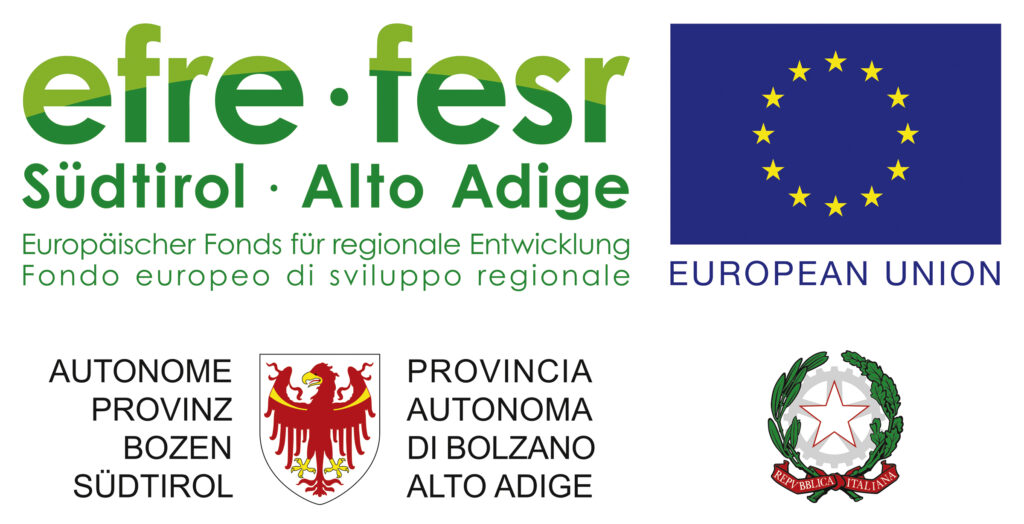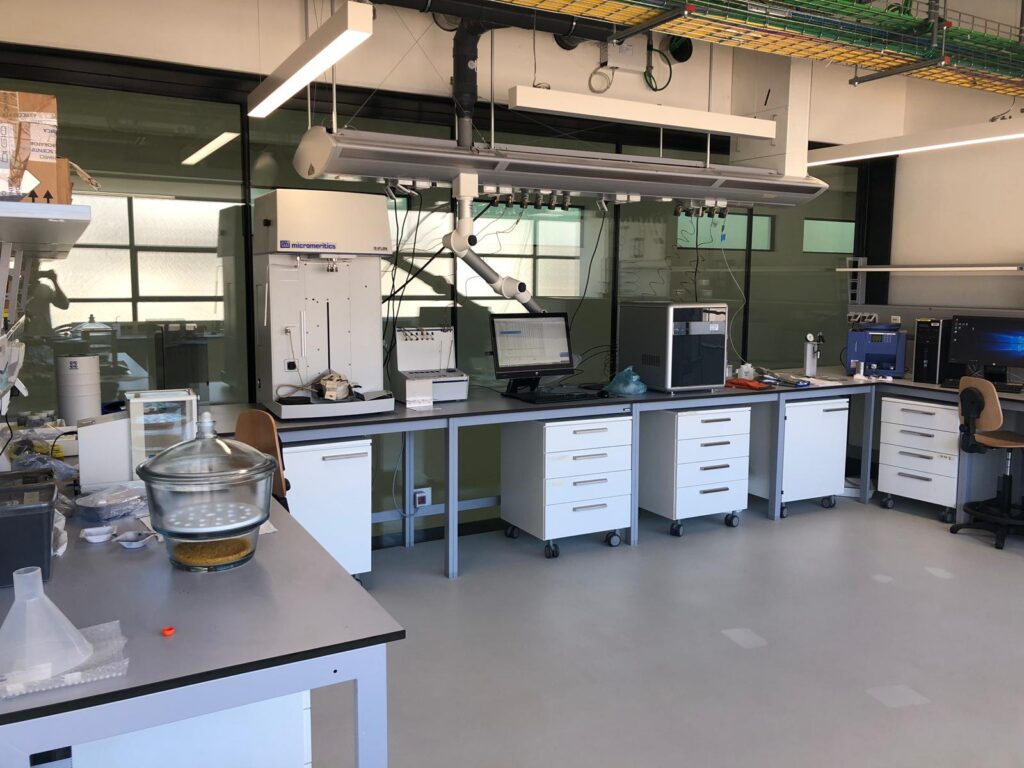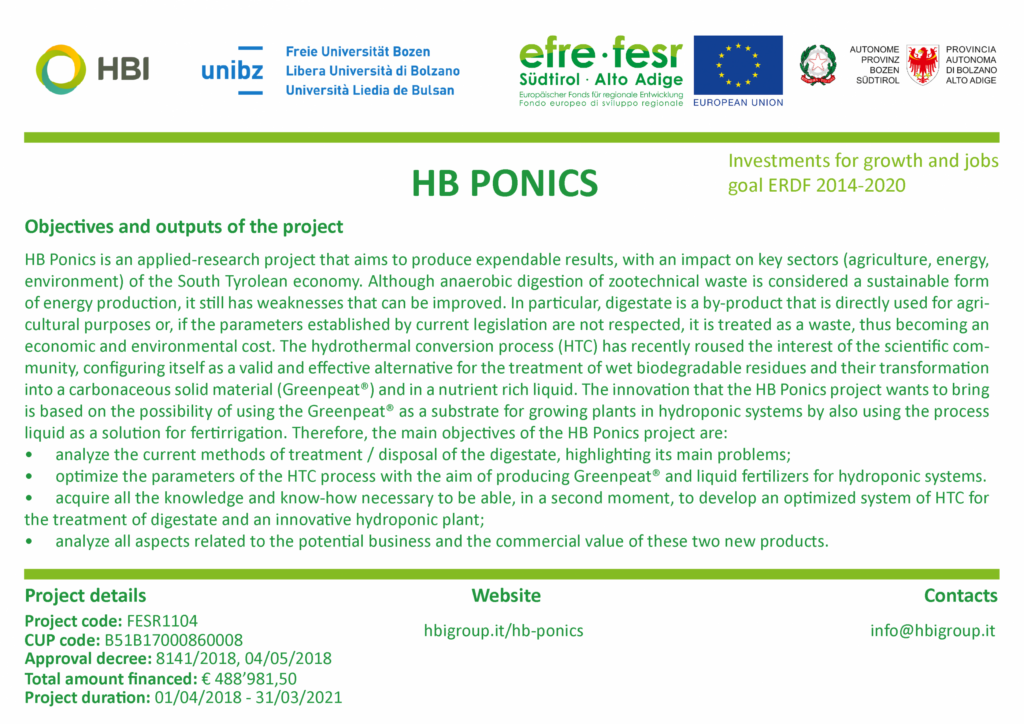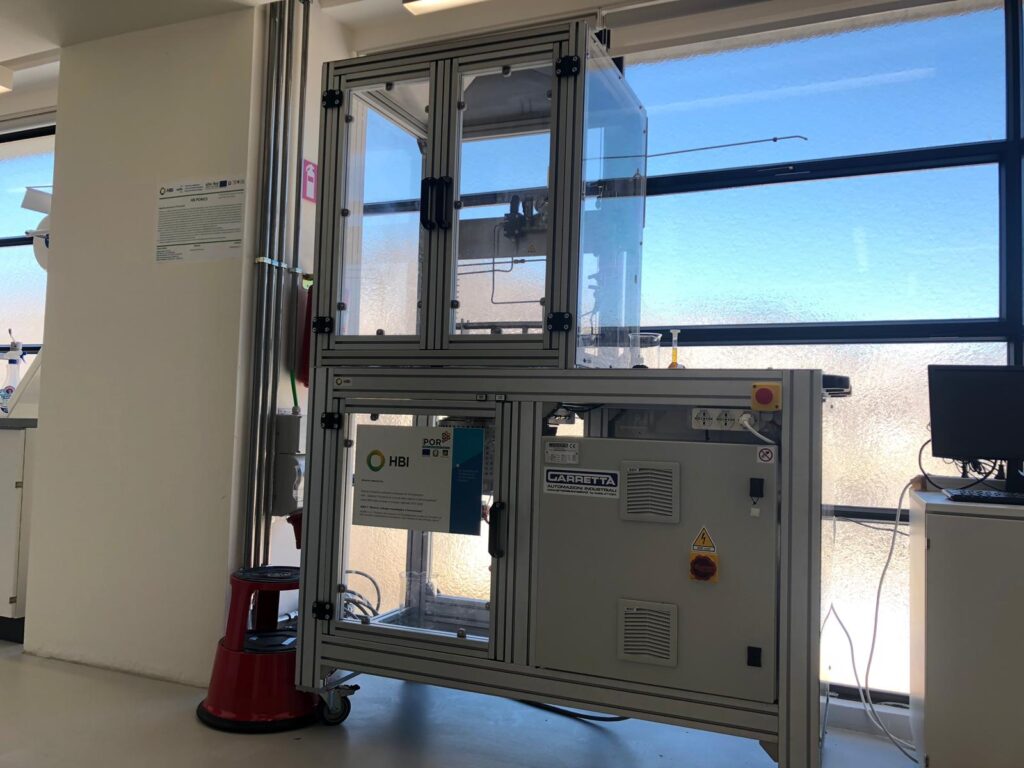The Project
OBJECTIVES and OUTPUTS
HB Ponics is an applied-research project that aims to produce expendable results, with an impact on key sectors (agriculture, energy, and environment) of the South Tyrolean economy. Although anaerobic digestion (hereinafter, AD) of zoo-technical waste is considered a sustainable form of energy production, it still has weaknesses that can be improved. In particular, digestate is a byproduct that is directly used for agricultural purposes or, if the parameters established by current
legislation are not respected, it is treated as a disposable waste, thus becoming an economic and environmental cost. The hydrothermal conversion process (HTC) has recently aroused the interest of the scientific community, configuring itself as a valid and effective alternative for the treatment of wet biomass and its transformation into a carbonaceous solid material (hereinafter, hydrochar) and in a nutrient rich liquid.
The innovation that the HB Ponics project wants to bring is based on the possibility of using hydrochar as a substrate for growing plants in hydroponic systems by also using the process liquid as a solution for fertirrigation.
Therefore, the main objectives of the HB Ponics project are:
• analyse the current methods of treatment / disposal of the digestate, highlighting its main problems;
• optimize the parameters of the HTC process with the aim of producing hydrochar and liquid fertilizers for hydroponic systems.
• acquire all the knowledge and know-how necessary to be able, in a second moment, to develop an optimized system of HTC for the treatment of digestate and an innovative hydroponic plant;
• analyze all aspects related to the potential business and the commercial value of these two new products.


PROJECT STRUCTURE
THE GENERAL STRUCTURE OF THE PROJECT
The HB Ponics project aims to study and propose a new innovative model for digestion valorization, bringing South Tyrol into a niche position with respect to this issue, fully respecting the principles of circular economy and sustainability. This objective will be achieved by following an approach that involves the academic and scientific world, in particular the Free University of Bolzano, which will work in close contact with HBI. At the beginning, needs and opportunities of the market will be analysed, both through the review of scientific literature and through targeted surveys on the territory (WP3). Subsequently, the digestate will be characterized both quantitatively and qualitatively (i.e., chemical and physical characterizations – WP3 and 4). The digestate will then be treated in a lab scale HTC reactor and the chemical-physical characteristics of the outputs (WP5) will be determined. The HTC process will also be modelled with commercial and open source software, in order for the consortium to built and adopt a predictive tool to be used in the design phase (WP5).
The HTC products will then be tested in conventional hydroponic systems, with the aim of optimizing these systems, both depending on the HTC products uses and on the type of selected crops (WP6).
The analysis of the technological positioning will be carried out by identifying potential competitor technologies and formulating hypotheses concerning the diversification of the product. In addition, an ad hoc business model will be studied and the business plan (WP7) will be improved. This will be followed by the analysis of the possible improvements concerning the HTC system for the treatment of the digestate and the hydroponic system that exploits the products generated by the HTC process (WP8). Finally, the main positive economic, environmental and social impacts for South Tyrol will be assessed (WP9).
WP3 – MARKET NEEDS AND OPPORTUNITIES
During WP3, a census of the AD plants will be carried out starting from the national territory and then completing the mapping by also including some other European countries. Parallel to this activity, a map of the AD plants will also be carried out at regional level to assess quality and availability of locally obtainable material.
The research activities will also have the aim of retrieving the information required for the activities of the subsequent WPs. In particular, the data regarding the digestate (e.g. type, quantity, chemical-physical variability, seasonality and interest in the new technological solution proposed) will be fundamental for the development of the technology and its optimization.
WP4 - DIGESTATE CHARACTERIZATION
During WP4 the following tasks will be performed:
• characterization of the chemical and physical properties of the digestates selected and sampled in WP3;
• evaluation of the digestate variability when changing the process parameters and the characteristics of the input materials, along with seasonal variations.
Both the chemical and physical characterizations of digestate will be carried out in cooperation with the Free University of Bolzano, according to the know-how developed by the Industrial Technical Physics group in the analysis of wood biomass and by-products of pyrolysis, gasification or roasting processes, as well as the experience of the Agricultural Chemistry group in the chemical characterization of organic compounds.
WP5 - HTC TREATMENT OF DIGESTATES AND PRODUCTS CHARACTERIZATION
During WP5, the following activities will be performed:
• HTC tests on selected substrates, varying the process conditions and characterizing the process products in terms of their chemical and physical characteristics;
• identification of the most significant properties of the HTC products for them to be used in hydroponic systems (i.e., the process liquid as a solution for fertirrigation and the hydrochar as a solid substrate for plants growth);
• evaluate any post-treatment necessary to obtain products eventually compatible with hydroponic systems.
The experimental tests on the digestates selected in the WP4 will be carried out in cooperation with the Free University of Bolzano, using a lab scale HTC reactor made and developed by HBI. Different process variables (e.g., temperature and water-substrate ratio) will be varied and the effects of these variations will be assessed in terms of yield and product characteristics.
WP6 - USE OF PRODUCTS DERIVING FROM THE HTC PROCESS FOR SOILLESS CULTURE
During WP6 the following activities will be performed:
• the possibility of using the HTC process liquid as concentrate fertilizer solution (fertirrigation solution) for plants and its effects on the growth of different plant species;
• the possibility of using hydrochars as substrates for plant growth;
• the optimal concentration of HTC process liquid in hydroponic solution depending on the plant typology;
• the possible interactions of HTC products with nutrients (deficiencies or nutritional toxicity).
The hydroponic experimental tests on the HTC products selected in the WP5 will be carried out in cooperation with the Free University of Bolzano, using a climatic chamber under controlled temperature and humidity conditions. The hydrochars will be tested to be used as possible substrates for plant growth. At the end of these tests, growth parameters will be evaluated both in terms of aerial and radical biomass and morphology (length/density of roots and leaf area). The data obtained from these analyses improve the know-how of the consortium on the effects of HTC products on different plant species in order to optimize the concentration of the HTC process liquid to be used in hydroponic solutions and as a possible fertirrigation solution along with hydrochar.
The evaluation of any deficiency or nutritional toxicity condition will also serve as a basis for the evaluation of possible nutrient integrations to the hydroponic solution, especially as a function of the plant typology.
WP7 - BUSINESS DEVELOPMENT
During this WP the technological positioning of both the HBI’s digestate treatment plant and the innovative hydroponic system will be evaluated. In particular, patents related to potential competing technologies will be analysed for structuring the product diversification. The most promising geographical areas for the market will be identified and the main players in the sector mapped. Therefore, hypotheses on the best product positioning strategy will be formalized. At the same time, the best market entry strategy (i.e., the go-to-market strategy) will be studied.
Furthermore, an economic-financial analysis will be carried out for the evaluation of the cash flows and the investment needs. The development of these activities will contribute to the improvement of the business plan, which will be periodically revised and updated.
WP8 – HTC PROCESS APPLIED TO THE DIGESTATE AND HYDROPONIC SYSTEM OPTIMIZATION
Based on the experimental results obtained in WP5 and WP6, this WP aims at optimizing both the HTC process and the hydroponic system. As far as the former is concerned, the optimal conditions for obtaining products with the most suitable characteristics for soilless application will be identified. Furthermore, the combined exploitation of the HTC process liquid (fertirrigation solution) and the hydrochar as a growth substrate in an integrated system will be evaluated. For this purpose, the expertise of the Industrial Technical Physics group of the Free University of Bolzano will be used, regarding in particular process simulation, using open-source and commercial software for the development of thermodynamic, kinetic and system models.
Once the model will be calibrated with the experimental data, it will be possible to evaluate the optimal process conditions according to the characteristics of the initial digestate, both in terms of energy efficiency and to maximize the most interesting features for the application of products in soilless systems. As far as the latter is concerned, an optimized and innovative system for the fertirrigation solution recirculation will be developed in order to reduce the loss of water resources and to increase the efficiency on nutrients usage.
WP9 - EVALUATION OF BENEFICIAL IMPACTS ON SOUTH TYROL AND IN OTHER POTENTIAL MARKETS
During this WP, other applications for the technological developments will be evaluated in order to identify other potential markets. For example, important industrial sectors characterized by residual biomass produced in large quantities will be considered according to their potential of being transformed into products that can be inserted in different markets (liquid phase for hydroponic cultures and hydrochar for growth substrates), through the technology developed by HBI in this
project. On the basis of this analysis, the possibility of expanding the business at national and international levels will be considered. The market analysis and the evaluations carried out in WP7 will allow the evaluation of projections for the years after the conclusion of the project.




